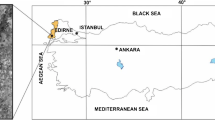Abstract
Digital surface models representing the heights of an area can be derived from two or more (multi-)stereo images of airborne or spaceborne sensors. A satellite stereo image of a current very-high-resolution satellite like WorldView or GeoEye with ground pixel sizes of about half a meter allows the derivation of surface models in the range of the same resolution. Such surface models are the basis of many applications like the three-dimensional representation of the area, 3D change detection, calculation of volumes, detection of sight lines, or water flow and flooding. Satellite imagery covers large areas of about 400 square kilometers with ground resolution of about 1 meter, while airborne images from planes or drones usually cover only small areas but with higher resolution. In this chapter the basics of digital surface models are shown, and the actually best method for deriving dense digital surface models from airborne and spaceborne images is described. Some examples finally show the possible results.
Access this chapter
Tax calculation will be finalised at checkout
Purchases are for personal use only
Similar content being viewed by others
References
Birchfield S, Tomasi C (1998) Depth discontinuities by pixel-to-pixel stereo. In: Proceedings of the 1998 IEEE international conference on computer vision, pp 1073–1080
d’Angelo P, Lehner M, Krauß T, Hoja D, Reinartz P (2008) Towards automated DEM generation from high resolution stereo satellite images. In: IAPRS, vol 37, pp 1137–1142
Grodecki J, Dial G, Lutes J (2004) Mathematical model for 3D feature ex-traction from multiple satellite images described by RPCs. In: ASPRS annual conference proceedings, Denver
Hirschmüller H (2005) Accurate and efficient stereo processing by semi-global matching and mutual information. In: IEEE conference on computer vision and pattern recognition (CVPR), vol 2, pp 807–814
Jacobsen K, Byksalih G, Topan H (2005) Geometric models for the orientation of high resolution optical satellite sensors. In: ISPRS workshop, Hannover, vol 36 (1/W3)
Krauß T, Reinartz P, Lehner M, Schroeder M, Stilla U (2005) DEM generation from very high resolution stereo satellite data in urban areas using dynamic programming. In: ISPRS workshop, Hannover, vol 36 (1/W3)
Lehner M, Gill RS (1992) Semi-automatic derivation of digital elevation models from stereoscopic 3-line scanner data. Int Arch Photogramm Remote Sens 29(B4):68–75
Otto GP, Chau TKW (1989) Region growing algorithm for matching of terrain images. Image Vis Comput 2(7):83–94
Scharstein D, Szeliski R (2002) A taxonomy and evaluation of dense two-frame stereo correspondence algorithms. Int J Comput Vis (IJCV) 47(1/2/3):7–42
Spangenberg R, Langner T, Rojas R (2013) Weighted semi-global matching and center- symmetric census transform for robust driver assistance. Comput Anal Images and Patterns 8048:34–41
van Meerbergen G, Vergauwen M, Pollefeys M, van Gool L (2002) A hierarchical symmetric stereo algorithm using dynamic programming. Int J Comput Vis 47(1/2/3):275–285
Zabih R, Woodfill J (1994) Non-parametric local transforms for computing visual correspondence. In: Computer vision – ECCV, vol 1994, pp 151–158
Author information
Authors and Affiliations
Corresponding author
Editor information
Editors and Affiliations
Rights and permissions
Copyright information
© 2020 Springer Nature Switzerland AG
About this chapter
Cite this chapter
Krauß, T. (2020). Dense Surface Models from Airborne and Spaceborne (Multi-)Stereo Images. In: Hadjimitsis, D., et al. Remote Sensing for Archaeology and Cultural Landscapes. Springer Remote Sensing/Photogrammetry. Springer, Cham. https://doi.org/10.1007/978-3-030-10979-0_6
Download citation
DOI: https://doi.org/10.1007/978-3-030-10979-0_6
Published:
Publisher Name: Springer, Cham
Print ISBN: 978-3-030-10978-3
Online ISBN: 978-3-030-10979-0
eBook Packages: Earth and Environmental ScienceEarth and Environmental Science (R0)




